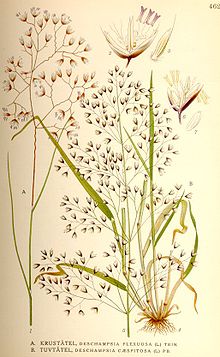Deschampsia
| Deschampsia | |
|---|---|

| |
| Deschampsia flexuosa (left) Deschampsia cespitosa (right)[4] | |
| Scientific classification | |
| Kingdom: | Plantae |
| Clade: | Tracheophytes |
| Clade: | Angiosperms |
| Clade: | Monocots |
| Clade: | Commelinids |
| Order: | Poales |
| Family: | Poaceae |
| Subfamily: | Pooideae |
| Supertribe: | Poodae |
| Tribe: | Poeae |
| Subtribe: | Aristaveninae F.Albers & Butzin |
| Genus: | Deschampsia P.Beauv.[1] |
| Type species | |
| Deschampsia cespitosa | |
| Synonyms[5] | |
| |
Deschampsia is a genus of plants in the grass family, commonly known as hair grass[6] or tussock grass. The genus is widespread across many countries.[7][8]
The genus is named for French physician and naturalist Louis Auguste Deschamps (1765–1842).[7][9]
Deschampsia species are used as food plants by the larvae of some species of Lepidoptera, including antler moth, the clay, clouded-bordered brindle, common wainscot, dark arches, dusky brocade, shoulder-striped wainscot, smoky wainscot and wall.
Deschampsia sometimes grow in boggy acidic formations, an example of which is the Portlethen Moss, Scotland. Deschampsia antarctica is the world's most southern monocot,[10][11] and one of only two flowering plants of Antarctica.[12][13]
Some species, such as D. cespitosa and D. flexuosa, are grown as ornamental garden plants.
Species[edit]
- Deschampsia airiformis (Steud.) Benth. & Hook.f. ex B.D.Jacks. – Chile, Argentina[5]
- Deschampsia angusta Stapf & C.E.Hubb. – Zaire, Kenya, Uganda
- Deschampsia antarctica E.Desv. – Chile, Argentina, Antarctica, Falkland Islands, South Georgia, Crozet Islands, Heard-McDonald Islands, Kerguelen Islands, South Sandwich Islands
- Deschampsia argentea Lowe – Azores, Madeira, Canary Islands
- Deschampsia atropurpurea (Wahlenb.) Scheele – northern Eurasia, North America, Chile, Argentina
- Deschampsia baicalensis Tzvelev – Irkutsk
- Deschampsia berteroniana (Kunth) F.Meigen – Chile, Argentina
- Deschampsia bottnica (Wahlenb.) Trin. – Kvarken Archipelago (part of Finland)
- Deschampsia cespitosa (L.) P.Beauv. – temperate, subarctic, and alpine regions in North America, Eurasia, Africa, Australia, various islands
- Deschampsia chapmanii Petrie – New Zealand incl Antipodes, Macquarie Islands
- Deschampsia christophersenii C.E.Hubb. – Tristan da Cunha
- Deschampsia cordillerarum Hauman – Chile, Argentina
- Deschampsia danthonioides (Trin.) Munro – Annual hairgrass – Alaska, Yukon, British Columbia, western USA, Mexico
- Deschampsia elongata (Hook.) Munro – Chile, Argentina, United States including Alaska, Canada, Mexico
- Deschampsia flexuosa (L.) Trin – Eurasia, alpine areas in Africa; northern North America, southern South America, Falkland Islands
- Deschampsia foliosa Hack. – Azores
- Deschampsia gracillima Kirk New Zealand including Antipodes, Tasmania
- Deschampsia kingii (Hook.f.) É.Desv. – Chile, Argentina
- Deschampsia klossii Ridl. – Lesser Sunda Islands, New Guinea
- Deschampsia koelerioides Regel – Siberia, Central Asia, China, Mongolia, Afghanistan, Pakistan
- Deschampsia laxa Phil. – Chile, Argentina
- Deschampsia leskovii Tzvelev – northern European Russia
- Deschampsia liebmanniana (E.Fourn.) Hitchc. – Mexico
- Deschampsia ligulata (Stapf) Henrard – Borneo
- Deschampsia looseriana Parodi – Chile
- Deschampsia maderensis (Hack. & Bornm.) Buschm. – Madeira
- Deschampsia media (Gouan) Roem. & Schult. – central and southern Europe, Morocco, Caucasus
- Deschampsia mejlandii C.E.Hubb. – Tristan da Cunha
- Deschampsia mendocina Parodi – Argentina
- †Deschampsia mexicana Scribn. – Mexico, apparently extinct
- Deschampsia mildbraedii Pilg. – Cameroon
- Deschampsia nubigena Hillebr. – Hawaii
- Deschampsia parvula (Hook.f.) É.Desv. – Chile, Argentina, Falkland Islands, Anvers Island
- Deschampsia patula (Phil.) Skottsb. – Chile, Argentina
- Deschampsia pusilla Petrie – New Zealand South Island
- Deschampsia robusta C.E.Hubb. – Tristan da Cunha
- Deschampsia setacea (Huds.) Hack. – northern and western Europe
- Deschampsia tenella Petrie – New Zealand
- Deschampsia venustula Parodi – Chile, Argentina
- Deschampsia wacei C.E.Hubb.- Tristan da Cunha
Formerly included[edit]
Deschampsia formerly included many species now placed in other genera, such as Aira, Antinoria, Bromus, Calamagrostis, Centropodia, Colpodium, Dissanthelium, Holcus, Periballia, Peyritschia, Poa, Trisetum and Vahlodea.[5]
References[edit]
- ^ "Genus: Deschampsia P. Beauv". Germplasm Resources Information Network. United States Department of Agriculture. 1999-03-09. Archived from the original on 2011-07-21. Retrieved 2011-03-07.
- ^ lectotype designated by Nash in N. L. Britton et A. Brown, Ill. Fl. N.U.S. ed. 2. 1: 215. 7 Jun (1913)
- ^ Tropicos, Deschampsia P.Beauv.
- ^ illustration circa 1920 from Bilder ur Nordens Flora by Carl Axel Magnus Lindman
- ^ a b c "World Checklist of Selected Plant Families".
- ^ "Deschampsia". Integrated Taxonomic Information System. Retrieved 2011-03-07.
- ^ a b Palisot de Beauvois, Ambroise Marie François Joseph. 1812. Essai d'une Nouvelle Agrostographie 91 descriptions in Latin, etymology explained in French
- ^ Palisot de Beauvois, Ambroise Marie François Joseph. 1812. Essai d'une Nouvelle Agrostographie, plate XVIII (18) figure III (3) line drawing of Deschampsia cespitosa
- ^ Jstor Deschamps, Louis Auguste (1765-1842)
- ^ Young, Mark C., ed. (1955). Guinness Book of World Records 1997. Guinness Publishing Ltd. pp. 42. ISBN 0-9652383-0-X.
- ^ Wali, Mohan K.; Evrendilek, Fatih; Fennessy, M. Siobhan (July 2009). The Environment: Science, Issues, and Solutions. CRC Press. p. 21. ISBN 978-1-4200-0733-6. Retrieved 25 Sep 2016.
- ^ Smith, Ronald I.L.. 1984 Terrestrial plant biology of the sub-Antarctic and Antarctic. In: Laws, R.M., (ed.) Antarctic Ecology, vol. 1. London, Academic Press, 61-162.
- ^ Holderegger, Rolf; Stehlik, Ivana; Lewis Smith, Ronald I.; Abbott, Richard J. (May 2003). "Populations of Antarctic Hairgrass (Deschampsia antarctica) Show Low Genetic Diversity". Arctic, Antarctic, and Alpine Research. 35 (2): 214–217. doi:10.1657/1523-0430(2003)035[0214:POAHDA]2.0.CO;2.
